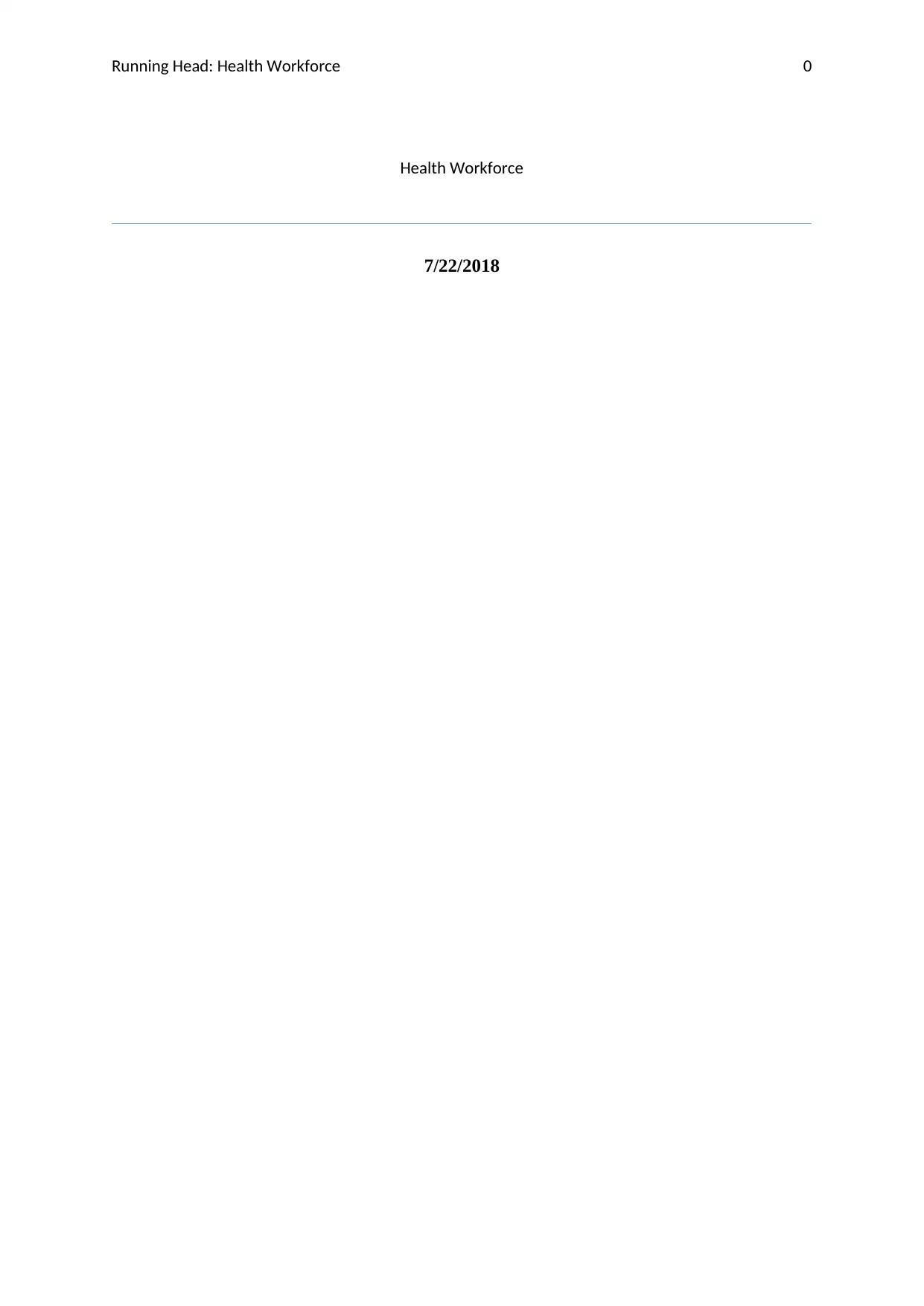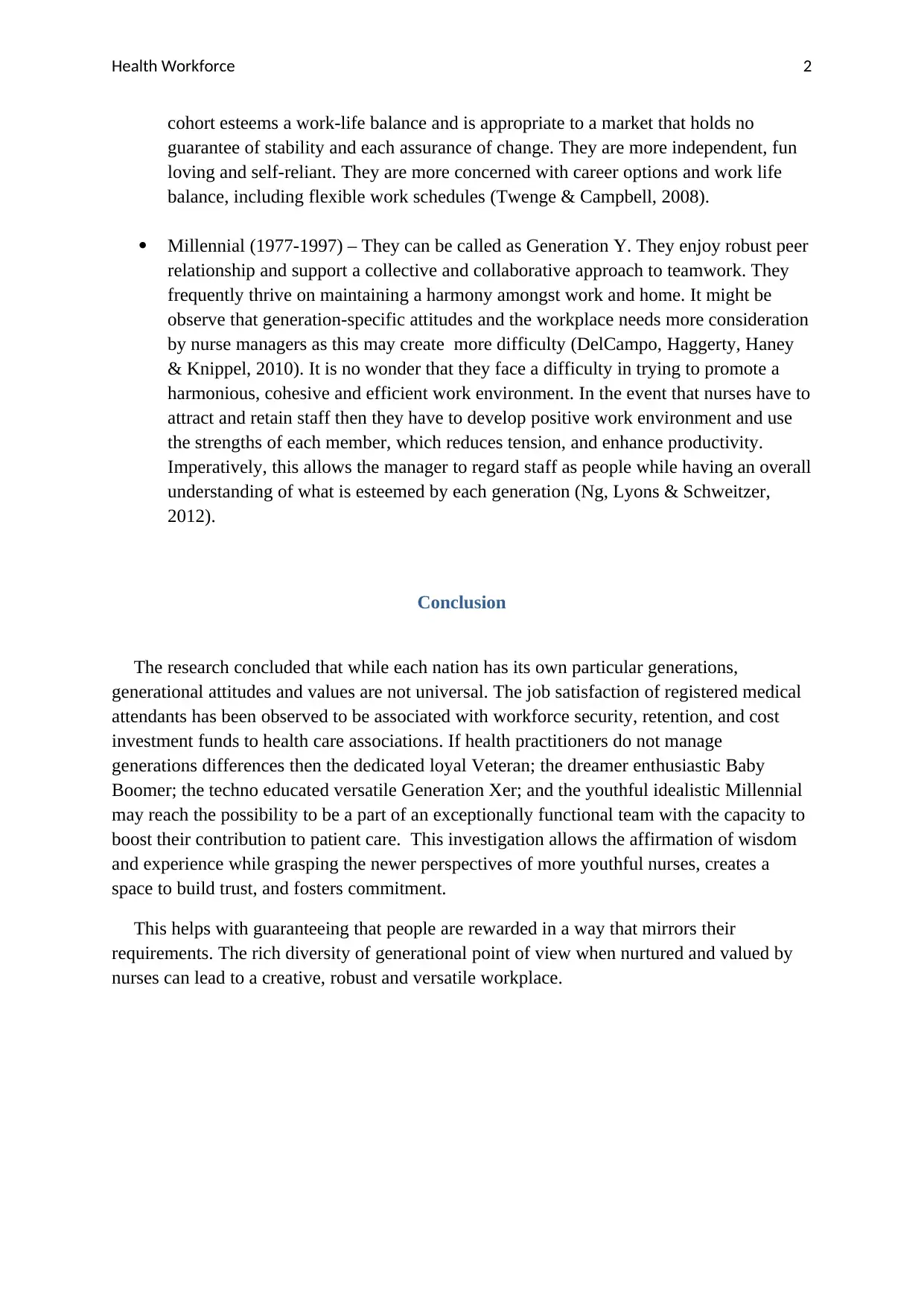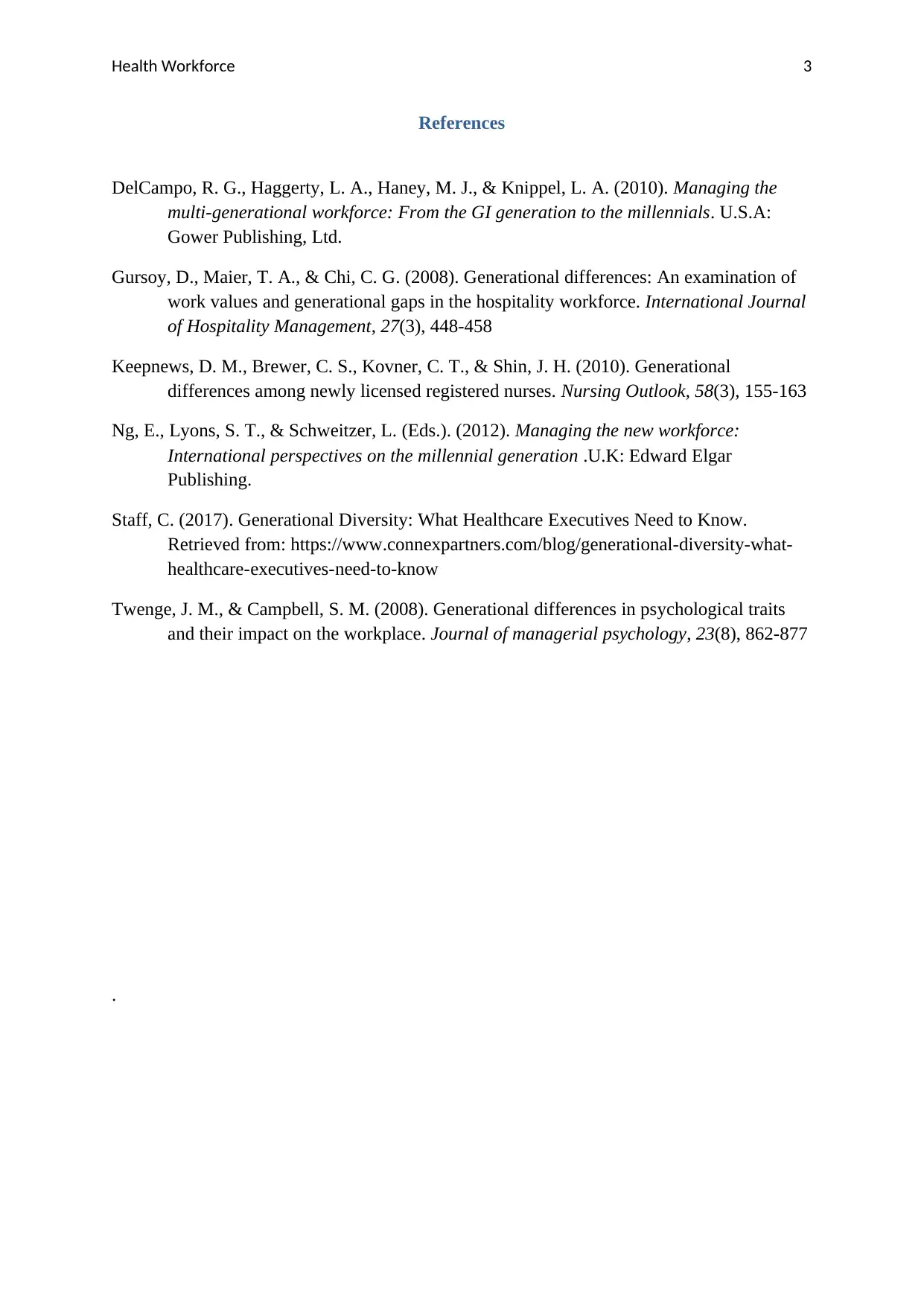Health Workforce: Generational Diversity in Healthcare - Analysis
VerifiedAdded on 2023/06/10
|5
|1146
|243
Discussion Board Post
AI Summary
This discussion board post examines the concept of generational diversity within the health workforce, emphasizing its importance in creating a richer and more accepting workplace environment. The post argues that embracing generational diversity allows for a broader scope of practice by integrating the varied experiences and knowledge of different generations in healthcare, thus fostering harmony and staff retention. It provides an overview of the characteristics and work values of the Veterans, Baby Boomers, Generation X, and Millennials, highlighting their unique perspectives and the potential challenges and benefits of their interactions. The discussion emphasizes the need for healthcare managers to understand and address generational differences to promote a cohesive and efficient work environment, ultimately improving patient care and workforce satisfaction. The post concludes that by valuing and nurturing these diverse generational viewpoints, the healthcare setting can cultivate a creative, robust, and versatile workplace, leading to increased staff contributions and improved patient outcomes.

Running Head: Health Workforce 0
Health Workforce
7/22/2018
Health Workforce
7/22/2018
Paraphrase This Document
Need a fresh take? Get an instant paraphrase of this document with our AI Paraphraser

Health Workforce 1
Generational Diversity in Health workforce-
Introduction
Generational Diversity simply means having individuals of a widespread range of diverse
ages represented in the workplace. People of different ages can bring very different
viewpoints, particularly in the age of rapid technological progress. They have different life
experiences, different perspectives, and different ideas, which help in better innovation and
problem solving in the organization. Having a combination of older and younger employees
provides a perfect opportunity for coaching and mentoring to take place within the
organization, and allowing individual to learn and become superior at their jobs (Keepnews,
Brewer, Kovner & Shin, 2010).
They should build a robust and strong generational foundation. They should understand
the employee profile so that they can improve programs and policies that encourage all
generations at all stages of the organization. The present healthcare environment faces many
difficulties in responding to the requirements of patients and workforce issues. In my opinion,
it is a vital issue in designing workplaces that retain the present generation and attracts the
younger generation of nurses. Generational difference creates new difficulties to maintain a
harmonious work place due to the merging of ages in the work setting. This brings diversity
and a mix of clinical experiences that stimulate patient care, yet the combination of
generations in the workplace may bring clashes and difficulties. Howe argued the challenge
stays with generational groups of nurses who have differences in values and attitudes to the
workplace (Gursoy, Maier & Chi, 2008).
Deciphering Generational Diversity
The Veterans (1925-1945) - Veterans have understanding of economic hardship and
living through the considerable wars. These experiences interpret teamwork, loyalty,
respect for hierarchy and authority, dedication, reward for diligent work, discipline
and seniority privilege in the veterans associate. Medical attendants in this cohort are
although having plans to resign are being encouraged to stay in the workforce to
counteract ‘brain drain’. This generation makes decisions centred on a utilitarian
authority and respect and adhere to rules (Staff, 2017).
Baby Boomers (1946-1964) – They grew up in a relatively consistent state of free
expression, educational growth and economic prosperity. They affirm this group work
with individual satisfaction and self-esteem. Boomers want to be recognized and
esteemed for their commitment through work-related recognition or ‘perks’. This
generation coined the saying ‘workaholic’.
Generation X (1965-1980) – The nursing alumni of this generation are individualistic
in their way to deal with and do not align themselves with the ethos of being an
individual from a group. They have learned how to deal with their own opportunity
set their own limits and get their work finished without supervision. Strikingly this
Generational Diversity in Health workforce-
Introduction
Generational Diversity simply means having individuals of a widespread range of diverse
ages represented in the workplace. People of different ages can bring very different
viewpoints, particularly in the age of rapid technological progress. They have different life
experiences, different perspectives, and different ideas, which help in better innovation and
problem solving in the organization. Having a combination of older and younger employees
provides a perfect opportunity for coaching and mentoring to take place within the
organization, and allowing individual to learn and become superior at their jobs (Keepnews,
Brewer, Kovner & Shin, 2010).
They should build a robust and strong generational foundation. They should understand
the employee profile so that they can improve programs and policies that encourage all
generations at all stages of the organization. The present healthcare environment faces many
difficulties in responding to the requirements of patients and workforce issues. In my opinion,
it is a vital issue in designing workplaces that retain the present generation and attracts the
younger generation of nurses. Generational difference creates new difficulties to maintain a
harmonious work place due to the merging of ages in the work setting. This brings diversity
and a mix of clinical experiences that stimulate patient care, yet the combination of
generations in the workplace may bring clashes and difficulties. Howe argued the challenge
stays with generational groups of nurses who have differences in values and attitudes to the
workplace (Gursoy, Maier & Chi, 2008).
Deciphering Generational Diversity
The Veterans (1925-1945) - Veterans have understanding of economic hardship and
living through the considerable wars. These experiences interpret teamwork, loyalty,
respect for hierarchy and authority, dedication, reward for diligent work, discipline
and seniority privilege in the veterans associate. Medical attendants in this cohort are
although having plans to resign are being encouraged to stay in the workforce to
counteract ‘brain drain’. This generation makes decisions centred on a utilitarian
authority and respect and adhere to rules (Staff, 2017).
Baby Boomers (1946-1964) – They grew up in a relatively consistent state of free
expression, educational growth and economic prosperity. They affirm this group work
with individual satisfaction and self-esteem. Boomers want to be recognized and
esteemed for their commitment through work-related recognition or ‘perks’. This
generation coined the saying ‘workaholic’.
Generation X (1965-1980) – The nursing alumni of this generation are individualistic
in their way to deal with and do not align themselves with the ethos of being an
individual from a group. They have learned how to deal with their own opportunity
set their own limits and get their work finished without supervision. Strikingly this

Health Workforce 2
cohort esteems a work-life balance and is appropriate to a market that holds no
guarantee of stability and each assurance of change. They are more independent, fun
loving and self-reliant. They are more concerned with career options and work life
balance, including flexible work schedules (Twenge & Campbell, 2008).
Millennial (1977-1997) – They can be called as Generation Y. They enjoy robust peer
relationship and support a collective and collaborative approach to teamwork. They
frequently thrive on maintaining a harmony amongst work and home. It might be
observe that generation-specific attitudes and the workplace needs more consideration
by nurse managers as this may create more difficulty (DelCampo, Haggerty, Haney
& Knippel, 2010). It is no wonder that they face a difficulty in trying to promote a
harmonious, cohesive and efficient work environment. In the event that nurses have to
attract and retain staff then they have to develop positive work environment and use
the strengths of each member, which reduces tension, and enhance productivity.
Imperatively, this allows the manager to regard staff as people while having an overall
understanding of what is esteemed by each generation (Ng, Lyons & Schweitzer,
2012).
Conclusion
The research concluded that while each nation has its own particular generations,
generational attitudes and values are not universal. The job satisfaction of registered medical
attendants has been observed to be associated with workforce security, retention, and cost
investment funds to health care associations. If health practitioners do not manage
generations differences then the dedicated loyal Veteran; the dreamer enthusiastic Baby
Boomer; the techno educated versatile Generation Xer; and the youthful idealistic Millennial
may reach the possibility to be a part of an exceptionally functional team with the capacity to
boost their contribution to patient care. This investigation allows the affirmation of wisdom
and experience while grasping the newer perspectives of more youthful nurses, creates a
space to build trust, and fosters commitment.
This helps with guaranteeing that people are rewarded in a way that mirrors their
requirements. The rich diversity of generational point of view when nurtured and valued by
nurses can lead to a creative, robust and versatile workplace.
cohort esteems a work-life balance and is appropriate to a market that holds no
guarantee of stability and each assurance of change. They are more independent, fun
loving and self-reliant. They are more concerned with career options and work life
balance, including flexible work schedules (Twenge & Campbell, 2008).
Millennial (1977-1997) – They can be called as Generation Y. They enjoy robust peer
relationship and support a collective and collaborative approach to teamwork. They
frequently thrive on maintaining a harmony amongst work and home. It might be
observe that generation-specific attitudes and the workplace needs more consideration
by nurse managers as this may create more difficulty (DelCampo, Haggerty, Haney
& Knippel, 2010). It is no wonder that they face a difficulty in trying to promote a
harmonious, cohesive and efficient work environment. In the event that nurses have to
attract and retain staff then they have to develop positive work environment and use
the strengths of each member, which reduces tension, and enhance productivity.
Imperatively, this allows the manager to regard staff as people while having an overall
understanding of what is esteemed by each generation (Ng, Lyons & Schweitzer,
2012).
Conclusion
The research concluded that while each nation has its own particular generations,
generational attitudes and values are not universal. The job satisfaction of registered medical
attendants has been observed to be associated with workforce security, retention, and cost
investment funds to health care associations. If health practitioners do not manage
generations differences then the dedicated loyal Veteran; the dreamer enthusiastic Baby
Boomer; the techno educated versatile Generation Xer; and the youthful idealistic Millennial
may reach the possibility to be a part of an exceptionally functional team with the capacity to
boost their contribution to patient care. This investigation allows the affirmation of wisdom
and experience while grasping the newer perspectives of more youthful nurses, creates a
space to build trust, and fosters commitment.
This helps with guaranteeing that people are rewarded in a way that mirrors their
requirements. The rich diversity of generational point of view when nurtured and valued by
nurses can lead to a creative, robust and versatile workplace.
⊘ This is a preview!⊘
Do you want full access?
Subscribe today to unlock all pages.

Trusted by 1+ million students worldwide

Health Workforce 3
References
DelCampo, R. G., Haggerty, L. A., Haney, M. J., & Knippel, L. A. (2010). Managing the
multi-generational workforce: From the GI generation to the millennials. U.S.A:
Gower Publishing, Ltd.
Gursoy, D., Maier, T. A., & Chi, C. G. (2008). Generational differences: An examination of
work values and generational gaps in the hospitality workforce. International Journal
of Hospitality Management, 27(3), 448-458
Keepnews, D. M., Brewer, C. S., Kovner, C. T., & Shin, J. H. (2010). Generational
differences among newly licensed registered nurses. Nursing Outlook, 58(3), 155-163
Ng, E., Lyons, S. T., & Schweitzer, L. (Eds.). (2012). Managing the new workforce:
International perspectives on the millennial generation .U.K: Edward Elgar
Publishing.
Staff, C. (2017). Generational Diversity: What Healthcare Executives Need to Know.
Retrieved from: https://www.connexpartners.com/blog/generational-diversity-what-
healthcare-executives-need-to-know
Twenge, J. M., & Campbell, S. M. (2008). Generational differences in psychological traits
and their impact on the workplace. Journal of managerial psychology, 23(8), 862-877
.
References
DelCampo, R. G., Haggerty, L. A., Haney, M. J., & Knippel, L. A. (2010). Managing the
multi-generational workforce: From the GI generation to the millennials. U.S.A:
Gower Publishing, Ltd.
Gursoy, D., Maier, T. A., & Chi, C. G. (2008). Generational differences: An examination of
work values and generational gaps in the hospitality workforce. International Journal
of Hospitality Management, 27(3), 448-458
Keepnews, D. M., Brewer, C. S., Kovner, C. T., & Shin, J. H. (2010). Generational
differences among newly licensed registered nurses. Nursing Outlook, 58(3), 155-163
Ng, E., Lyons, S. T., & Schweitzer, L. (Eds.). (2012). Managing the new workforce:
International perspectives on the millennial generation .U.K: Edward Elgar
Publishing.
Staff, C. (2017). Generational Diversity: What Healthcare Executives Need to Know.
Retrieved from: https://www.connexpartners.com/blog/generational-diversity-what-
healthcare-executives-need-to-know
Twenge, J. M., & Campbell, S. M. (2008). Generational differences in psychological traits
and their impact on the workplace. Journal of managerial psychology, 23(8), 862-877
.
Paraphrase This Document
Need a fresh take? Get an instant paraphrase of this document with our AI Paraphraser

Health Workforce 4
1 out of 5
Related Documents
Your All-in-One AI-Powered Toolkit for Academic Success.
+13062052269
info@desklib.com
Available 24*7 on WhatsApp / Email
![[object Object]](/_next/static/media/star-bottom.7253800d.svg)
Unlock your academic potential
Copyright © 2020–2025 A2Z Services. All Rights Reserved. Developed and managed by ZUCOL.





